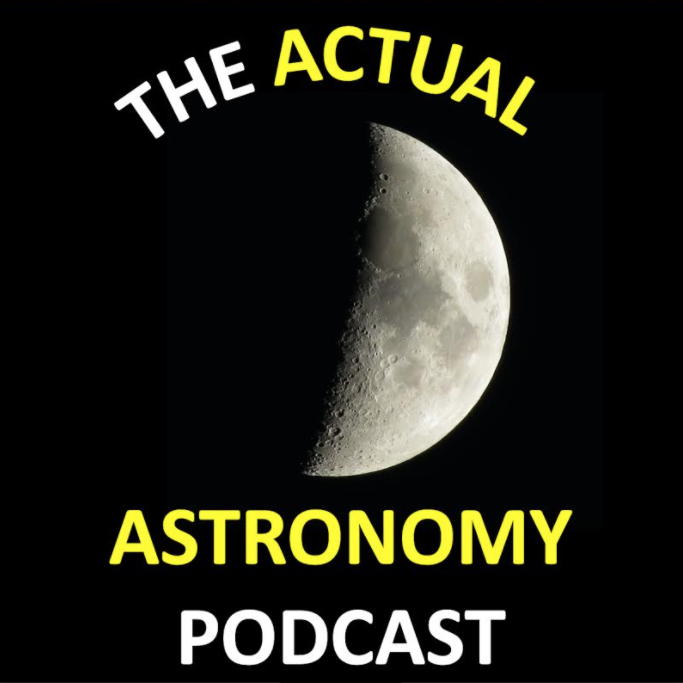Podcaster: Shane and Chris

Title: Actual Astronomy: Listener Emails
Organization: Actual Astronomy
Link : https://actualastronomy.podbean.com/ ; https://www.deepskyeye.com/
Description: The Actual Astronomy Podcast presents The Observer’s Calendar for September 2025. In this episode we talk about how to see Venus pass by the Beehive cluster, features on the Moon like the Wargetin Pancake, the Moon Pairing with Saturn, Pleiades, Jupiter before occulting Venus. Saturn is also at opposition this month and a possible bright comet is on the horizon!
Bio: Shane and Chris are amateur astronomers who enjoy teaching astronomy classes and performing outreach where they help the eyes of the public to telescope eyepieces.
Today’s sponsor: Big thanks to our Patreon supporters this month: Paul M. Sutter, Chris Nealen, Frank Frankovic, Frank Tippin, Jako Danar, Michael Freedman, Nik Whitehead, Rani Bush, Ron Diehl, Steven Emert, Brett Duane, Don Swartwout, Vladimir Bogdanov, Steven Kluth, Steve Nerlich, Phyllis Foster, Michael W, James K Wood, Katrina Ince, Cherry Wood.
Please consider sponsoring a day or two. Just click on the “Donate” button on the lower left side of this webpage, or contact us at signup@365daysofastronomy.org.
Please visit our Patreon page: https://www.patreon.com/365DaysOfAstronomy
or you can consider to sponsor a day of our podcast : https://cosmoquest.org/x/365daysofastronomy/product/sponsor-an-episode-of-365-days-of-astronomy/
Transcript:
Observer’s Calendar for September 2025 Episode 498 of the Actual Astronomy podcast. I’m Chris and joining me is Shane. We are amateur astronomers who love looking up at the night sky and this podcast is for everyone who enjoys going out under the stars.
Sept 1 – Aurigids ZHR=10 related to Comet Keiss
The comet was discovered by Carl Clarence Kiess at Lick Observatory on a photographic plate obtained in the morning hours of 6 July 1911 with the Crocker photographic telescope. The comet appeared as a distorted nebulous object with a short tail. The presence of the comet was confirmed visually the next day. The comet had a well condensed nucleus and a faint tail. In photographs the tail was four degrees long. The comet then was of seventh magnitude and moving southwards. A preliminary orbit suggested the comet was past its perihelion upon discovery and it was calculated that it would approach Earth at a distance of 0.27 AU (40 million km; 25 million mi) on 20 August. On 19 August the comet was reported to be visible with the naked eye, peaking at an estimated apparent magnitude of 5.
The comet had been suggested in 1911 to be the return of comet C/1790 A1 (Herschel), also known by its old designation, 1790 I.However, further calculations revealed that the orbit of comet Kiess had an eccentricity too high for an orbital period of 122 years, with the orbit calculated by Louis Lindsey in 1932 indicating an orbital period of 1,903 years.
Venus 1.5 from Beehive in morning sky
Sept 5 – Wargentin Pancake Visible – Bottom left of Moon
Sept 7 – Full Moon & Lunar Eclipse – Can’t see it here but Central to West Au and centred on India.
Sept 8 – Saturn, Neptune and Moon Congregate in late evening sky
Sept 11 – Carbon Star R Fornacis best tonight
Sept 12 – Moon 1-degree North of Pleiades
Sept 14 – Last quarter Moon
NGC 7552 well placed tonight
Sept 15 – Lunar Curtis X Visible
Zodiacal light visible in Eastern morning sky next two weeks
Sept 16 Jupiter South of Moon
Sept 17 – Follow Capella unaided eye into daylight this week.
Sept 19 – Regulus, Venus and Moon form a tight triangle in early morning sky Moon Occults Venus at 7am est.
Sept 21 – Saturn at opposition
Partial Solar Eclipse
Sept 22 – Fall Equinox and Gegenshein visible from dark sites, high in S at midnight
Sept 23 – Neptune at Opposition
Sept 25 – Comet 414P visible this morning Faint?
Sept 26 – Carbon Star R Leporis best tonight
Sept 29 – Last Quarter and Maginus Ray feature visible on Moon
Concluding Message: Please subscribe and share the show with other stargazers you know and send us show ideas, observations and questions to actualastronomy@gmail.com
365 Days of Astronomy
=====================
The 365 Days of Astronomy Podcast is produced by Planetary Science Institute. Audio post production by Richard Drumm, project management by Avivah Yamani, and hosting donated by libsyn.com. This content is released under a creative commons Attribution-NonCommercial 4.0 International license. Please share what you love but don’t sell what’s free.
This show is made possible thanks to the generous donations of people like you! Please consider supporting our show on Patreon.com/CosmoQuestX and get access to bonus content. Without your passion and contribution, we won’t be able to share the stories and inspire the worlds. We invite you to join our community of storytellers and share your voice with listeners worldwide.
As we wrap up today’s episode, we are looking forward to unravel more stories from the Universe. With every new discovery from ground-based and space-based observatories, and each milestone in space exploration, we come closer to understanding the cosmos and our place within it.
Until next time and let the stars guide your curiosity!
